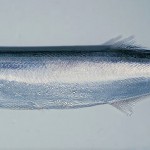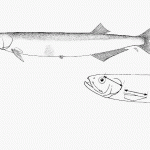Species: Chirocentrus nudus
English Name: Whitefin Wolf-herring
Chinese Name: 長頷寶刀魚
Family: Chirocentridae
Description:
A silvery, bright blue (fading to grey) back with bright silver flanks wolf-herring. Can grow up to a length of 100 cm. Lives inshore and preys on small fishes and crabs. Highly commercialized for human consumption.


Photos used under a Creative Commons license
References:
– Whitehead, P.J.P., 1985. FAO Species Catalogue. Vol. 7. Clupeoid fishes of the world (suborder Clupeioidei). An annotated and illustrated catalogue of the herrings, sardines, pilchards, sprats, shads, anchovies and wolf-herrings. FAO Fish. Synop. 125(7/1):1-303. Rome: FAO.

